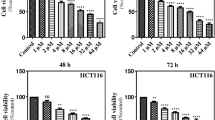Abstract
The present study was conducted to explore the potential role of proteasome pathway in NSAIDs-induced apoptosis. We employed sulindac as a NSAID, and chose the lactacystin for inhibition of proteasome activity. Assessment of apoptosis and proteasome activity assay were undertaken. We demonstrated that sulindac treatment resulted in a decrease of proteasome activity, and that the co-treatment of a proteasome inhibitor lactacystin potentiated the extent of sulindac-induced apoptosis in HT-29 cells by augmentation of the decrease in proteasome activity. Elucidation of the mechanism underlying the regression of colon cancers by combinations of sulindac and lactacystin seems to be an immediate challenge for the near future.
Similar content being viewed by others
References
Rosenberg L, Palmer JR, Zauber AG, Warshauer ME, Stolley PD, Shapiro S. A hypothesis: Nonsteroidal anti-inflammatory drugs reduce the incidence of large-bowel cancer. J Natl Cancer Inst 1991; 83355–358.
Pasricha PJ, Bedi A, O'Connor K, et al. The effects of sulindac on colorectal proliferation and apoptosis in familial adenomatous polyposis. Gastroenterology 1995; 109994–998.
Piazza GA, Rahm AK, Finn TS, et al. Apoptosis primarily accounts for the growth-inhibitory properties of sulindac metabolites and involves a mechanism that is independent of cyclooxygenase inhibition, cell cycle arrest, and p53 induction. Cancer Res 1997; 572452–2459.
Shiff SJ, Qiao L, Tsai LL, Rigas B. Sulindac sulfide, an aspirinlike compound, inhibits proliferation, causes cell cycle quiescence, and induces apoptosis in HT-29 colon adenocarcinoma cells. J Clin Invest 1995; 96491–503.
Pique M, Barragan M, Dalmau M, Bellosillo B, Pons G, Gil J. Aspirin induces apoptosis through mitochondrial cytochrome c release. FEBS Lett 2000; 480193–196.
Thun MJ, Henley SJ, Patrono C. Nonsteroidal anti-inflammatory drugs as anticancer agents: Mechanistic, pharmacologic, and clinical issues. J Natl Cancer Inst 2002; 94252–266.
Meng L, Kwok BH, Sin N, Crews CM. Eponemycin exerts its antitumor effect through the inhibition of proteasome funtion. Cancer Res 1999; 592798–2801.
Drexler HC, Risau W, Konerding MA. Inhibition of proteasome function induces programmed cell death in proliferating endothelial cells. FASEB J 2000; 1465–77.
Orlowski RZ. The role of the ubiquitin-proteasome pathway in apoptosis. Cell Death Differ 1999; 6303–313.
Grimm LM, Goldberg AL, Poirier GG, Schwartz LM, Osborne BA. Proteasome play an essential role in thymocyte apoptosis. EMBO J 1996; 153835–3844.
Sadoul R, Fernandez PA, Quiquerez AL, et al. Involvement of the proteasome in the programmed cell death of NGF-deprived sympathetic neurons. EMBO J 1996; 153845–3852.
Li B, Dou QP. Bax degradation by the ubiquitin/proteasomedependent pathway: Involvement in tumor survival and progression. Pro Natl Acad Sci USA 2000; 973850–3855.
Orlowski RZ, Eswara JR, Lafond-Walker A, Grever MR, Orlowski M, Dang CV. Tumor growth inhibition induced in a murine model of human Burkitt's lymphoma by a proteasome inhibitor. Cancer Res 1998; 584342–4348.
Adams J, Palombella VJ, Sausville EA, et al. Proteasome inhibitors: A novel class of potent and effective antitumor agents. Cancer Res 1999; 592615–2622.
Chandra J, Niemer I, Gilbreath J, et al. Proteasome inhibitors induce apoptosis in glucocorticoid-resistant chronic lymphocytic leukemic lymphocytes. Blood 1998; 924220–4229.
Delic J, Masdehors P, Omura S, et al. The proteasome inhibitor lactacystin induces apoptosis and sensitizes chemo-and radioresistant human chronic lymphocytic leukaemia lymphocytes to TNF-alpha-initiated apoptosis. Br J Cancer 1998; 771103–1107.
Fanelli M, Minucci S, Gelmetti V, nervi C, Gambacorti-Passerini C, Pelicci PG. Constitutive degradation of PML/RARalpha through the proteasome pathway mediates retinoic acid resistance. Blood 1999; 93477–481.
Golab J, Stoklosa T, Czajka A, et al. Synergistic antitumor effects of a selective proteasome inhibitor and TNF in mice. Anticancer Res 2000; 201717–1721.
Loda M, Cukor B, Tam SW, et al. Increased proteasomedependent degradation of the cyclin-dependent kinase inhibitor p27 in aggressive colorectal carcinomas. Nat Med 1997; 3231–234.
Chen F, Chang D, Goh M, Klibanov SA, Ljungman M. Role of p53 in cell cycle regulation and apoptosis following exposure to proteasome inhibitors. Cell Growth Differ 2000; 11239–246.
Author information
Authors and Affiliations
Corresponding author
Rights and permissions
About this article
Cite this article
Choi, H.J., Kim, H.H., Lee, H.S. et al. Lactacystin augments the sulindac-induced apoptosis in HT-29 cells. Apoptosis 8, 301–305 (2003). https://doi.org/10.1023/A:1023681007766
Issue Date:
DOI: https://doi.org/10.1023/A:1023681007766




